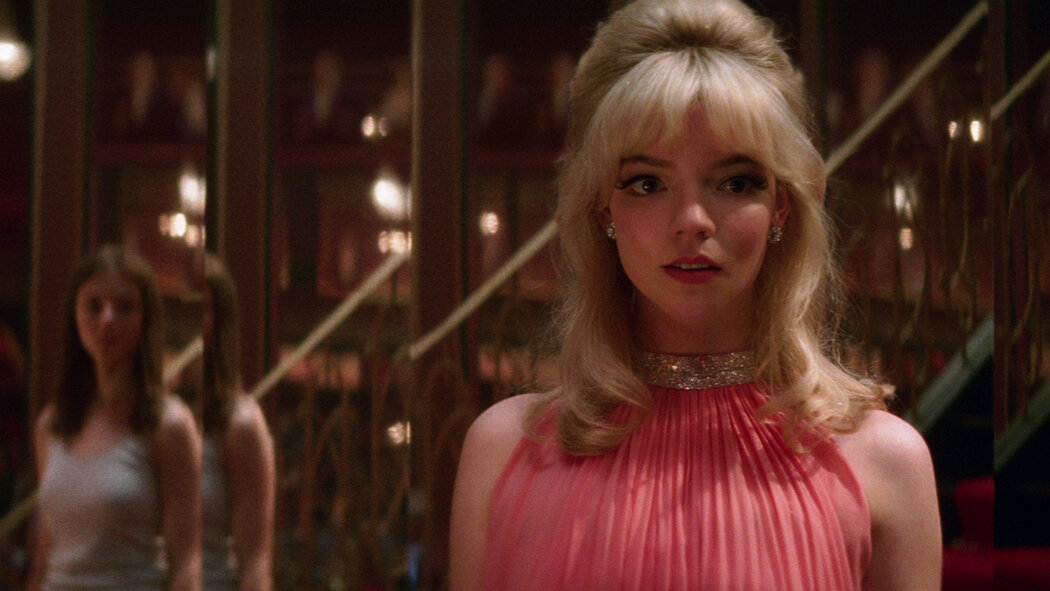Welcome to my first post in a series of eight in which I will analyze eight different films — and the themes, devices, and ideas they employ — across two genres. Occurring every other Friday, the first four posts will be about psychological thrillers, and the latter four will be about science fiction. Today, I’m kicking it off with a piece on a brand new thriller: Edgar Wright’s 2021 picture, Last Night in Soho.
“If I could live any place and any time, I’d live here, in London in the ‘60s,” says Ellie (Thomasin McKenzie), a bright-eyed girl who’s just moved to the city of her dreams. But those dreams soon turn into nightmares as she discovers that London is not what she thought it was, and behind the bedazzled glamor of its past lie sinister secrets. She begins having dreams about Sandie (Anya Taylor-Joy), an aspiring singer in the ‘60s, and what starts out as a fun adventure quickly becomes twisted with fear, indignity, and violence. Via its perversion of nostalgia and its employment of the uncanny, Last Night in Soho warns against the fetishization of the past.
The film is lush with the nostalgic, swinging music of the 1960s which Ellie so adores, but, as the narrative progresses, the situations in which this music is heard increasingly pervert that feeling of nostalgia, indicating that the past is not as fun and bright as it sounds. The first instance of this is when, after an overwhelming first day in the big city, Ellie lies in bed and starts listening to “Starstruck” by The Kinks, seeking to relax and feel safe. But, to her horror, her roommate Jocasta (Synnove Karlsen) bursts through the door with a boy groping at her. The two of them pay no mind to Ellie as they start having sex, totally violating her privacy. The next piece to be perverted is “Downtown” by Petula Clark. When Ellie first hears it in an early vision, Sandie delivers a beautiful and inspiring audition at a nightclub. When it is next heard, Ellie is playing it on vinyl as she falls asleep and begins to be taken by the dream. She sees an image of Sandie, bathed in red light, as the sound of her pumping heart becomes louder alongside an eerie ringing, creating a sense of anxiety that directly contrasts the hopefulness it first represented. This trend continues throughout the movie, causing the classic tunes to leave a bad taste for both Ellie and the viewer.
Wright expertly uses the uncanny to unnerve the audience and create a feeling of repulsion toward the past. The word “uncanny” is derived from the German word Unheimlich, which roughly means “unhomely.” Ellie, having lived with her grandma since she was seven, feels out of place in the dormitory. She moves in with an old lady, who lives in a house from the ‘60s, so that she will “feel more at home.” Unfortunately, while her new room is familiar, it is far from homely. Constantly flashed with red light by the sign of the Bistro nextdoor and haunted with visions of the past, Ellie begins to fear her bedroom, not even wanting to sleep in her own bed. She begins to experience doppelgangers, ghosts, and deja vu, all of which are among the most common forms of the uncanny. In the mirror, she sees herself as Sandie, a girl with aspirations much like hers which were stolen and replaced by sexual abuse. Everywhere she looks, Ellie is plagued by ghosts of the men who abused Sandie — first in her dreams, and then in real life. The film is rampant with deja vu that blurs the line between dream and reality, but the most unnerving occurence is when she discovers a mark on her neck at school — one that was left by a man kissing her/Sandie’s neck in the dream. This all leaves her disgusted and frightened by the city and the era for which she once yearned.
By invoking and then perverting nostalgia, and by making use of the uncanny, Last Night in Soho delivers a chilling message: the past which is so often romanticized is secretly brimming with violation, pain, and death just beneath the surface. It implores the viewer not to naively pine for a bygone era, but to acknowledge the evils of yesterday so that we can move on today. Next time, the psychological thrills will continue as I take a look at another of the enchanting Anya Taylor-Joy’s works: Split (2017), one of her first major roles. Be sure to keep an eye out for it!


Recent Comments